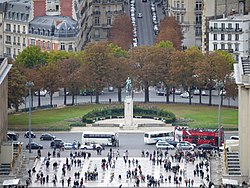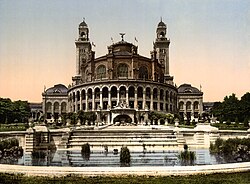Trocadéro, Paris
This article needs additional citations for verification. (June 2019) |


The Trocadéro (pronounced [tʁɔkadeʁo] ⓘ), site of the Palais de Chaillot, is an area of Paris, France, in the 16th arrondissement, across the Seine from the Eiffel Tower. It is also the name of the 1878 Trocadéro Palace which was demolished in 1937 to make way for the Palais de Chaillot.[1] The hill of the Trocadéro is the hill of Chaillot, a former village.
Origin of the name

The place was named in honour of the
François-René de Chateaubriand said "To stride across the lands of Spain at one go, to succeed there, where Bonaparte had failed, to triumph on that same soil where the arms of the fantastic man suffered reverses, to do in six months what he couldn't do in seven years, that was truly prodigious!"[3]
Nowadays the square is officially named Place du Trocadéro et (and) du 11 Novembre (for the WWI armistice), although it is usually simply called the Place du Trocadéro.
Palais du Trocadéro

The hill of Chaillot was first arranged for the 1867
The concert hall contained a large
Below the building in the space left by former underground quarries, a large aquarium was built to contain fish of French rivers. It was renovated in 1937 but closed again for renovation from 1985 until 22 May 2006.
Within its garden, the old palace contained two large animal statues, of a rhinoceros and an elephant, which were removed and stored during the demolition of the old Trocadero palace, and have been located next to the entrance of the Musée d'Orsay since 1986.
Palais de Chaillot


For the
The buildings are decorated with quotations by
The buildings now house a number of museums:
- the Musée national de la Marine (naval museum) and the Musée de l'Homme (ethnology) in the southern (Passy) wing.
- the Cité de l'Architecture et du Patrimoine, including the Musée national des Monuments Français, in the eastern (Paris) wing, from which one also enters the Théâtre national de Chaillot, a theater below the esplanade.
It was on the front terrace of the palace that
Jardins du Trocadéro


The Jardins du Trocadéro occupy the open space bounded to the northwest by the wings of the Palais de Chaillot and to the southeast by the Seine and the Pont d'Iéna.
The present garden has an area of 93,930 square metres (23.21 acres) and was created for the
Others
Five avenues originate in the Trocadéro: the Avenue Henri-Martin, which links the Trocadéro with the Porte de la Muette and passes in front of the
There is a large municipal library (the Germaine Tillion Library, named after the resistance member and ethnologist) near (to the west of) the Trocadéro's square.
The high retaining walls of the Trocadero cemetery (
Education
The Institut Culturel Franco-Japonais – École Japonaise de Paris opened at the Trocadéro in 1973. It moved to its current location at Montigny-le-Bretonneux in 1990.[12]
Access
| Located near the Trocadéro .
|
Trocadéro today
Trocadéro is a popular tourist destination to take pictures of the
See also
References
- ^ "Palais de Chaillot. Chaillot museums". Paris Digest. 2018. Retrieved 2018-12-31.
- ^ La batalla de Trocadero, bahía de Cádiz. Luis Pueyo. https://revistadehistoria.es/la-batalla-de-trocadero-bahia-de-cadiz/
- ^ "Enjamber d'un pas les Espagnes, réussir là où Bonaparte avait échoué, triompher sur ce même sol où les armes de l'homme fantastique avaient eu des revers, faire en six mois ce qu'il n'avait pu faire en sept ans, c'était un véritable prodige!"
- ^ "Trocadéro" (in French). Insecula. Archived from the original on 2 November 2010. Retrieved 11 July 2011.
Le terrain restera à l'état de friche jusqu'à l'Exposition Universelle de 1878. Gabriel Davioud, qui s'était illustré en dessinant la place Saint-Michel en 1867, et Jules Bourdais construiront sur ce terrain un palais mauresque néo-byzantin aux ailes déployées autour d'une rotonde centrale, piquée d'une paire de minarets.
- ^ Koch, Georg (2015). "Charles-Marie Widor / Symphonie VI / op. 42/2" (PDF). Carus-Verlag. pp. VIII. Retrieved 14 July 2018.
- ^ Aquarium du Trocadéro Archived June 9, 2008, at the Wayback Machine Retrieved 2019-04-15
- ^ ISBN 9782860003513), p. 22
- ^ Archives d'architecture du XXe siècle, Volume 1 by Institut français d'architecture, Maurice Culot, page 158
- ^ "Trocadéro". Insecula.com. Archived from the original on 2010-11-02. Retrieved 2014-03-10.
- ISBN 9782852291416)
- ISBN 0-910413-06-1
- ISBN 9781780939803, p. 84.
- ^ Manny Di Branson aka Gilles Poitou
External links
- Photos of Trocadero in Paris
- View and description of the Trocadéro
- Images of the old Palais du Trocadéro
- Images of the Palais de Chaillot
- The Palais de Chaillot while it was being renovated
- Commemorative stone dedication on Trocadéro Human Rights Plaza, October 17, 1987
- Virtual tour 360 degrees in fullscreen. Use your mouse to turn around !
- France, Paris, Trocadéro Virtual tour with map and compass effect by Tolomeus
